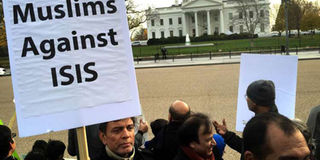Isis and its variants are top security threat

A Shia Muslim holds a banner in protest against ISIS and the use of terrorism in the name of Islam during a religious procession of US Shia Muslims at Lafayette Square, outside the White House in Washington, DC on December 6, 2015. PHOTO | AFP PHOTO
What you need to know:
- There is now an increasing trend pointing to a shift in the terrorist group’s modus operandi as conditions on ground begin to gradually shift against the Islamic State.
- At its peak, it is estimated that the terrorist group made about $5 million US dollars a day from selling oil on the black market.
- In an effort to remain relevant and to assuage the multi-pronged assaults against it, Islamic State has already started opening up new fronts, tapping into a global pool of sympathisers or hardcore fighters returning from the main theatre of conflict to launch attacks outside Syria and Iraq.
The violent Salafi terrorist group infamous for its insatiable appetite for violence has already been linked to numerous deadly terrorist attacks around the world from the Middle East, Africa, and Europe to Southeast Asia.
There is now an increasing trend pointing to a shift in the terrorist group’s modus operandi as conditions on ground begin to gradually shift against the Islamic State.
Major assaults by a combined Russian and Syrian forces on one hand and a series of operations by the Iraqi army and the US forces and its allies on the other, have not only disrupted oil supply, the main source of revenue for the terrorist group but have also managed to stall and, in some cases, wind back the group’s successes.
At its peak, it is estimated that the terrorist group made about $5 million US dollars a day from selling oil on the black market.
Turkey, Saudi Arabia and Qatar, some of the regional countries with vested interests in events unfolding in Syria are drumming up support for a possible ground invasion. All these activities continue to mount pressure on Islamic State’s strongholds in Syria and Iraq.
In an effort to remain relevant and to assuage the multi-pronged assaults against it, Islamic State has already started opening up new fronts, tapping into a global pool of sympathisers or hardcore fighters returning from the main theatre of conflict to launch attacks outside Syria and Iraq.
Islamic State’s reach and zone of operation is increasingly assuming a global dimension.
Fighters from Europe, Asia and Africa are in Iraq and Syria fighting for the terrorist group. Closer home and although there has been no official confirmation by the government, all indications are that some Kenyans may have already found their way to the Middle East and joined Islamic State ranks.
THREAT TO SECURITY
The threat to global security by the terrorist group will likely continue to originate from three main sources. The first source will be attacks perpetrated by new affiliates or existing radical Islamist groups switching allegiance to the Islamic State.
The groups that are pledging allegiance to Isis are disgruntled Taliban members in Afghanistan; affiliated groups operating predominantly in the Sinai region in Egypt and Boko Haram in Nigeria. In Southeast Asia, a group made up of predominantly Malay-speaking Indonesians and Malaysians and affiliated to the Islamic State is suspected to have carried out the deadly Jakarta terrorist attack in January this year.
The second source of threat will be returnees from the Islamic State fuelled conflict in the Middle East. Once the terrorist group is sufficiently degraded, contained and the territory it occupies now seized, mounting pressure on combatants will force them to flee the theatre of conflict.
The third source, equally as effective in its impact as the first two will be lone wolf attacks by individuals not directly linked to or operationally directed Islamic State but inspired by its ideology.
A genuine global approach with strong regional backing is what will tilt conditions on the ground against the Isis.
The parallel efforts by the US, Russian and Syrian forces need to be merged. There has to be a compromise that will see President Bashar al Assad play a role in stabilising the country, followed by a transition to a government that fully represents the Syrian people.
The inclusion of Russia, Iran, Turkey and other key regional players is vital to the success of any lasting solution to the mess in Syria.
There is also a need for sustained pressure from the international community on the Iraq Shia majority government to engage in a genuine and inclusive effort to resolve long standing and deep seated sectarian differences in the country.
The writer is a security analyst; [email protected] or twitter:@gitaanyasani




